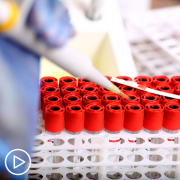Myeloma Test Results and Factors That Impact Treatment Decisions from Patient Empowerment Network on Vimeo.
Myeloma expert Dr. Rafael Fonseca reviews considerations that impact treatment choices, including the role of test results and how quality of life can factor in when choosing therapy.
Dr. Rafael Fonseca is the interim director of Mayo Clinic Cancer Center and serves as the director for Innovation and Transformational Relationships at Mayo Clinic in Arizona. Learn more about Dr. Fonseca here.
See More From Engage Myeloma
Related Programs:
Transcript:
Katherine:
What other factors do you consider when determining a treatment approach?
Dr. Fonseca:
The human experience that comes to the bedside as we consider treatments is so multi-factorial and multi-complex that all that needs to be brought into consideration. Whenever I walk into the room, I tell residents usually the medical part can be resolved pretty quick, but we’re reading how much we can communicate? What’s the level of understanding? What do I understand about the support system for this person? Is there someone who can drive to the treatment center? Is there someone perhaps whose other medical conditions would create certain challenges in how they’re going to be treated?
This person is telling me they do daily hikes for four miles. Well, that’s different from someone who I see comes into the clinic and has to use a cane. We try to integrate all of that information to make the right decisions. I’ve made a lot of my career in the early years working and showing how, for instance, genetic factors are important. I’ve come to realize later in my career and through some of the very elegant work that other colleagues have done, that these factors are just as important in determining the ultimate outcome of patients. Whenever I talk about that clinical experience, there’s two things I always tell the residents.
I use the residents a lot because I think it’s a good example of how we aspire to interact with patients. Number one is every single encounter is a final exam. You have to put your best foot forward. Every single encounter should be considered a final exam. Number two is when I walk into that room, there are three things I do, particularly the first time I meet a person.
Number one is connect, right? We cannot have a conversation and I’m not going to be able to move forward unless we have a human connection and I have gained the trust of the patient and the family members that are there. That’s number one. The second point is decide. That is usually okay, we’re going to do this treatment or that. That is a small part. Most of the time for me, that’s a very small fraction of the time and of the mental energy that I consume. There are cases that are more complicated, but most of the time it’s pretty straightforward. So, it’s connect, decide do very small, and then on the other end is explain.
So, that’s how I can connect. I propose we do this, and then why we are going to do it and what can you expect. If you can do those three things, I think that goes a long way in establishing a fruitful and a productive relationship with a patient and their families.
Katherine:
I would suspect that you also take into consideration the patient’s health, their age, maybe test results, side effects, things like that?
Dr. Fonseca:
Of course. So, we look at the medical record and with the advent, of course, of the electronic record and all the tests that we do, our consideration is quite complex. We have to look at all those factors, and the age, and comorbidities. It’s rare that we would take one factor alone that would trump everything else. We usually have to integrate the information. The same is true when we manage myeloma patients and we’re monitoring their protein levels and their response to treatment. I tell patients, they ask me, “What would you do? What’s the magic number for this or that?”
I say, “It’s a little bit like you’re flying a Cessna plane and you have all these dials in your dashboard, and that’s how we manage the situation is the integration of all of that information.”
Katherine:
Right. Can you help us understand, Dr. Fonseca, how test results may affect treatment options?
Dr. Fonseca:
Sure. Happy to do that. In myeloma, we are very fortunate in that we have, and it’s not the topic for today, but we have the best biomarker that exists for any cancer. That is that we can measure the proteins that are associated with the growth of the cells. We have multiple tests that we can do. We do them in the blood and we do them in the urine. They’re simple tests that have been done for decades now that allow us to monitor how a person is doing with regards to their disease. I use the following analogy. Myeloma cells live inside the bones, as I mentioned, in the bone marrow.
They don’t come out into the blood. So, we cannot measure them. Indirectly, we can measure how many they are and how they are behaving by measuring this protein. I use an analogy of imagine you’re walking in a street, and you see smoke coming out of a building. There are two things you can do. First is you diagnose that there is a fire inside the building, right? We see that with myeloma by measuring these abnormal proteins.
Then as a firefighting team comes on, you can gauge whether they’re making progress or not by the amount of smoke that comes out. That’s exactly what we do when we monitor myeloma. We monitor the M-spike, the serum free light chain, the urinary proteins. That’s how we make those determinations.
At the same time, we do that, we have to look indirectly at the rest of the body. We have to look at the kidney function. We have to look at the blood counts. We have to look at the hemoglobin and the red cell count because that can A) start on the wrong foot because of the myeloma itself, but B) can also suffer as a consequence of our treatment.
It is, again, that idea of having the multiple dials in the dashboard that allow us to reach our practice. We have to be adjusting. So, if we measure the proteins and we’re doing great, but then at the same time we see we’re suffering in blood counts, and we may need to adjust those as we provide supportive treatment. If we don’t see the proteins go down, then that may mean we need to change to a different form of treatment or that the person is unfortunately a refractory or relapsing to something.
So, that’s how we integrate the test results into our management.




















